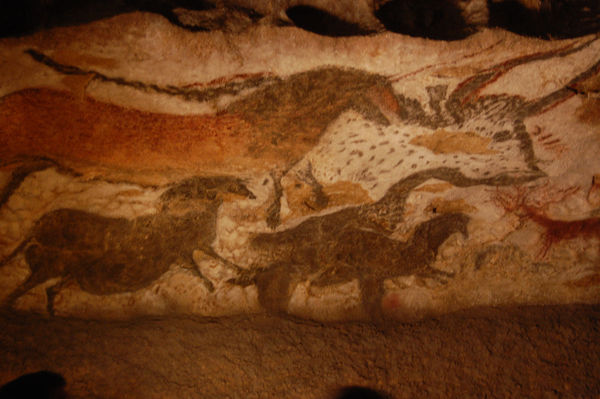Digging Europe’s Wondrous Caves
By Rick Steves

Europe is rich in history, but its splendid castles, antique churches, and age-old ruins tell only part of the story. To dig even deeper in time — much deeper — visit a cave. Some of my favorites, in France and Slovenia, showcase 17-foot-long bulls drawn by our ancient forebears and 100-foot-high stalagmites sculpted by nature.
The world's most famous cave paintings are at Lascaux, in southwest France. From 18,000 to 10,000 BC, long before Stonehenge, before the pyramids, before metalworking, and before farming — back when mammoths and saber-toothed cats still roamed the earth — prehistoric people painted deep inside these limestone caverns. These aren't crude doodles with a charcoal-tipped stick. They're sophisticated, costly, and time-consuming engineering projects.
Discovered in 1940, the caves were closed to visitors in 1963 to prevent further deterioration of the artwork. But two "copy caves" — Lascaux II and Lascaux IV, at the International Center for Cave Art — replicate the original with exacting accuracy. The prehistoric reindeer, horses, and bulls of the original cave have been painstakingly reproduced by talented artists using the same dyes, tools, and techniques their predecessors did 15,000 years ago. When I first heard a guide call the Lascaux caves the "Sistine Chapel of the prehistoric world" I thought, "Promotional hyperbole." But once inside, I was swept away by the grandeur. The paintings are astonishing, and the experience is mystifying.
Lascaux IV, designed with the latest technology, is a slightly more exact copy, and its state-of-the-art center gives a thorough and thought-provoking overview of the original cave and its role in prehistory and modern art. In high season, however, it can have a circus-like feel as groups of 35 people are ushered in every six minutes. The older Lascaux II, in the woods a half mile away, offers a more intimate, quiet, and intensive look.
To see actual original prehistoric art, head to the Grotte de Font-de-Gaume. Even if you're not a connoisseur of Cro-Magnon culture, you'll dig this cave — the last one in France with prehistoric multicolored (polychrome) paintings still open to the public.
Font-de-Gaume contains 15,000-year-old paintings of 230 animals, including many red-and-black bison painted in elegant motion. When two animals face each other, one is black, and the other is red. Your guide, with a laser pointer and great reverence, will trace the faded outline of the bison and explain how, 15 millennia ago, cave dwellers used local minerals and the rock's natural contours to give the paintings dimension. But getting in is tricky — access is extremely restricted, with only 78 spaces available each day. Book as far ahead as far you can, particularly for high season, as spots fill up months in advance.
In Slovenia, the ancient story found below ground relates to geology, not human culture. About an hour south of Ljubljana, the country's Karst region is honeycombed with a vast network of caves and underground rivers. Spelunkers agree that this region has some of the most remarkable caves on the planet, including my favorite, the Škocjan caves.
At Škocjan, visitors begin by seeing a multitude of formations in a series of large caverns. Guides tell the story as, drip by drip, stalactites grow from spaghetti-thin strands to mighty sequoia-like stone pillars. The experience builds and builds as you go into ever-more impressive grottoes, and you think you've seen the best. But then you get to the truly colossal final cavern — the "Murmuring Water Cave" — with a mighty river crashing through the mist. A thousand evil Wizard of Oz monkeys could comfortably fly in formation through here. Crossing a breathtaking footbridge 150 feet above the torrent gives you faith in Slovenian engineering. Finally, the cave widens, sunlight pours in, and you emerge — like lost creatures seeking daylight — into a lush canyon.
The nearby Postojna caves are Slovenia's single most popular tourist attraction. Postojna lacks Škocjan's spectacular, massive-cavern finale, but the formations at Postojna are slightly more abundant, varied, and colorful, with stalagmites and stalactites as tall as 100 feet.
While some fairly strenuous hiking is required to see Škocjan, visiting Postojna is an easy, lightly guided roll-and-stroll through an amazing underground cavern. A little open-air train first slings you deep into the mountain, whizzing past wonderful formations. Then you walk uphill into the "Big Mountain," where you're surrounded by a sea of fairy chimneys, before a bridge over a canyon takes you into "Spaghetti Hall," named for the long, skinny stalactites that seem to be dripping from the ceiling. After passing some huge, white, melting-ice-cream formations, you wind up in the impressively vast cavern called the "Concert Hall." Here, an aquarium houses the strange, pale-pink, salamander-like "human fish," a cave-dwelling creature that is celebrated as a sort of national mascot in Slovenia.
After exploring some of the world's best caves, mull over what you've seen — and return to more modern history — with a glass of local wine from vineyards near these caves. Raise a glass to red-and-black bison, colossal caverns, and human fish that hide beneath Europe's modern surface.

